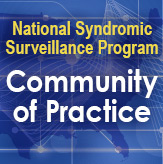Syndromic Surveillance for Mass Gatherings
Mass Gatherings

When large gatherings of people occur, the planning and response resources of the host state can become strained. West Virginia hosted a 10-day national youth event with more than 30,000 attendees descending on the southeastern part of the state in July 2017. The West Virginia Department of Health and Human Resources needed to monitor the event for injuries and outbreaks. They turned to syndromic surveillance to capture data from both on-site health clinics and hospitals.
The team used tools provided on the CDC National Syndromic Surveillance Program to conduct near real-time event surveillance to provide daily situational awareness reports and to measure burden on the healthcare system. This was the first time public health officials in West Virginia used syndromic surveillance at this event. They ran reports for event organizers, the Department of Homeland Security, the National Guard, and the governor’s office.
Syndromic surveillance provided timely, accurate data on the population affected by the event. If a threat to public health had occurred, syndromic surveillance would have allowed for a quick public health response and intervention. Funding from the National Syndromic Surveillance Program supports the use of syndromic surveillance in improving the nation’s public health.
Public Health Problem
Mass gatherings—defined as events attended by a sufficient number of people to strain the planning and response resources of the host state—pose unique surveillance challenges. Attendees can be at greater (or high) risk for injuries due to event activities or volume of people in an unstructured setting. Surveillance can help detect early signs of outbreaks associated with crowding and compromised sanitation. Public health officials must be prepared to enhance their surveillance capacity to detect and investigate an outbreak, mass exposure, or injury cluster that could damage the credibility of an event or exert a substantial human or economic impact.
Actions Taken
In July 2017, a national youth organization hosted a 10-day event in Southeastern West Virginia that attracted more than 30,000 youths, volunteers, and spectators. People needing medical attention visited on-site infirmaries. Anyone requiring intensive care was transported to a tertiary care hospital designated by organizers as the primary off-site care facility. An off-site surveillance team used NSSP–ESSENCE* to provide daily situational awareness reports to the joint information system. Patients were categorized by select syndromes (e.g., rash, injury, influenza-like illness, respiratory distress, and gastrointestinal illness) and by visitation status (admitted, transferred, discharged, and expired). Enhanced surveillance using ESSENCE enabled public health officials to conduct near real-time surveillance of the event and measure its burden on the healthcare system.
Outcome
Syndromic surveillance (SyS) is essential for monitoring the state’s health response capacity for mass gatherings. During this event, 75 people visited the primary care facility. Of these, 49 (67%) were discharged and returned on-site the same day. At least 29 visits (39%) were injury related (sprains, fractures, contusion), and 29 visits (39%) were classified as other (dehydration, heart attack, low blood pressure). Injury related and other were the most common reasons for visits. Off-site visits for injury and respiratory distress increased, peaking midway (day 5), when 11 patients (15%) were transported off-site and 6 patients (55%) were admitted for issues classified as other.
This was the first time public health officials conducted SyS at this event. They used ESSENCE to run reports for event organizers, Dept. of Homeland Security, National Guard, and the governor’s office. Affected area hospitals reported separately to public health officials, enabling them to evaluate the utility and validity of ESSENCE reports. SyS reports proved timely, provided accurate data on the population affected by the event, and summarized the most severe injuries and illness for organizers and public health officials. Had a threat to public health occurred, SyS would have identified syndrome patterns to allow for quick public health response and intervention. Public health officials plan to use NSSP–ESSENCE to monitor upcoming global (2019) and national (2021) events.
*Electronic Surveillance System for the Early Notification of Community-based Epidemics
Lessons Learned
- The use of syndromic surveillance during a mass gathering places less burden on public health officials than traditional, previously used methods of surveillance. Traditional methods require public health officials to call healthcare facilities daily to collect patient visit information.
- Syndromic surveillance requires fewer resources and personnel. As this was the first-time syndromic surveillance was used for this mass gathering event, public health officials overestimated the staff needed to conduct surveillance. For future events of this size, one or two staff members rotating shifts would be sufficient.
Contacts
Division of Infectious Disease Epidemiology
West Virginia Department of Health and Human Resources
Shannon.M.Mcbee@wv.gov
Office of Public Health Data, Surveillance, and Technology
Division of Health Informatics and Surveillance
www.cdc.gov/nssp
This success story shows how NSSP
- Improves Data Representativeness
- Improves Data Quality, Timeliness, and Use
- Strengthens Syndromic Surveillance Practice
- Informs Public Health Action or Response
The findings and outcomes described in this syndromic success story are those of the authors and do not necessarily represent the official position of the National Syndromic Surveillance Program or the Centers for Disease Control and Prevention.
